This is my complete guide to everything you need to know about the Choquequirao trek – from someone whose been there and done it!
Yup, brave the most formidable hike around Cusco I have and come out the other side successfully and lived to tell the tale I have too!
So if you’re wanting to buck the trend, get off the beaten track, set yourself a challenge, dodge the Inca Trail crowds or enjoy a hike that is perfect for smaller budgets, the Choquequirao trek is the one for you as well!
Here’s all the deets you should ever need to plan for, pack for and enjoy this incredible Peruvian hike…
Related Posts
- Top 21 Things to Do in Cusco… 9 of which are Free!
- 14 Best Cusco Hostels
- 55 Best Things To Do in South America
This page contains affiliate links meaning Big World Small Pockets may receive a small commission on any purchases at no extra cost to you.
My stay in Cusco was kindly part-sponsored by Milhouse Cusco Hostel but, as always, all views are my own.
Where and What is Choquequirao?
So let’s start with the basics, the Choquequirao trek is a hike that takes you to a huge set of Inca ruins (actually a city + ceremony site) called Choquequirao.
These ruins are set in the hills outside Cusco, away from both Machu Picchu and the Sacred Valley, which are where most other ruins in this part of Peru are found.
As such, Choquequirao is kind of special and there’s a lot of controversy among archaeologists / historians etc about why and when they were built.
Because, they are huge!
Still not fully excavated, the ruins of Choquequirao encompass a whole city, a mass of agricultural terraces and a ceremonial location.
Treks here generally depart from Cusco and return to this city too, with the trailhead being around a 4 hour drive from the city through the twisting-turning Andean roads and traditional villages.
Choquequirao hikes usually last between 3-5 days and can be made guided or unguided… we’ll discuss the pros and cons of these options later!
Accommodation and supplies along the way are limited and basic.
The trek is high, taking place entirely over 1500m and mostly between 2500-2700m above sea level with a high of around 3150m.
Why Make the Choquequirao Trek?
So why should you do this trek?
Will I’ve kinda spelt it out in the intro already (plus I don’t think it will take much to convince you) so I’ll keep this point brief!
The Choquequirao hike is an epic multi-day hike perfect for those looking to get off the beaten track.
It’s definitely one of the least known-about, and therefore least-hiked treks in and around Cusco – compared to the most popular ones around these here parts (like the Inca Trail or the Salkantay Trek) the Choquequirao trek has way fewer visitors.
This also makes it much cheaper – a winner for us budget travellers!
In addition, if you also want to spot some amazing, hidden Inca ruins away from the crowds (the day we arrived we saw less than 10 other people, which is a lot less than Machu Picchu I can tell you!) then this might also be the hike for you!
It pays to know, as well, that in around 2 year’s time (circa 2021) a cable car will be built to the Choquequirao ruins… the plans are already in place.
It’s then likely this spot will then become another tourist zoo, so if you want to get there before that… do this trek now!
And finally, this guy is a tough one – literally straight down and up the side of an Andean canyon at over 2500m, so if you want to set yourself a challenge – sign up for the Choquequirao trek!
When to Visit Choquequirao?
Travel seasons in Peru are often a little complicated, purely because of the diversity of this country’s topography.
When it’s summer on the coast, for example, it’s rainy in the mountains and when it’s cooler in the jungle, it’s freezing along the Pacific.
As such, you’re always going to be rolling the dice a little when you travel Peru, especially with global warming messing everything around too.
Bearing all that in mind however, the best time to visit Cusco and to attempt the Choquequirao trek is during the dry season in the Andes aka winter in Peru, which runs largely from the months of April through to October.
Although, it’s worth realising this coincides with the coldest time of the year too, especially during June and July, when it is not great temperatures for camping!
As such, I’d advise making the Choquequirao trek during the shoulder season… which is exactly what I did i.e. April & May or Sept & Oct!
Trying to combine the best of both worlds i.e. spring on the coast and dry season in the mountains, I visited Cusco in October and actually found it ideal as there were even less tourists (because it was shoulder season) but it was not yet too cold or wet.
That said, it can, of course, rain any time of year at this altitude, so maybe it was just luck!
Learn more about the best time to visit Peru in general here.
How to Organise Your Choquequirao Trek?
When it comes to organising your Choquequirao trek, you want to thank the disorganised travel gods that basically everything can be sorted out for this whole adventure when you’re in Cusco!
This applies to both those who want to do the trek self-guided and those who want to take a guided tour.
Sure you can book the trek through an agency online in advance, but you’re going to pay a lot more.
So, unless you’re on a super tight timeframe, I strongly advise you to arrive in Cusco a day or 2 before you want to hike (allowing time for altitude acclimation too) and book it there and then.
The only thing to bear in mind is that guided group Choquequirao hikes don’t run every day (like the other more popular multi-day walks around Cusco do) quite simply because there aren’t the same number of people doing it.
As such, you might have to wait a few days for a group to come together.
This is done by pooling all the participants from different travel agencies so, outside of the price they offer you, it doesn’t really matter which travel agency you book through – in the end, they all use one of just 2 companies that operate the route with guides and camping reservations etc.
Once you have your tour booked, just make sure you have all the supplies you’ll need – more about this in the packing section of this article – and you’re good to go.
Of course if you’re doing the trek unguided, you don’t need to worry about any of this!
Just arrive in Cusco, acclimatise to the altitude, make sure you have all the supplies you need, check the weather is looking good and set out!
To Guide Or Not to Guide?
So one of the best tips for budget travellers is that you don’t need a guide to visit Choquequirao.
Indeed you can use public transport to get to the trailhead from the city and, providing you take all your food and camping gear with you, can easily make arrangements as you go along and set up your tents in the available camping spots.
The trail is easy to follow (download maps.me beforehand) and going without a guide is not only cheaper, but allows you to set your own pace i.e. if you want to spend 2 nights at the ruins for example, you can.
The campsites you can stay at are in Capuliyoq, Cocamasana, Chiquisca, Playa Rosalina, Santa Rosa, Marampata and the ruins – although you have to be careful of the sand fly epidemic at those near the river (see the itinerary section below for information about which campsites I stayed in).
It’s likely that making the Choquequirao trek without a guide will take you longer – the public transport to the trailhead alone might take a full day to navigate and this could well push your trip to 5 days… depending on how fast you walk!
Although you can buy water and some food along the route, you’ll likely want to take quite a bit of food, plus cooking gear and certainly all camping gear with you.
(Although some campsites do offer basic rooms, not all do, so you will need to take a tent for at least some of the nights of your trek.)
All of this will, of course, make your pack heavier and on those steep ascents, it might prove pretty tough… to say the least!
Mostly because I didn’t want to be weighed down with all the kgs, I opted to take a guided tour on my Choquequirao hike.
I also quite fancied hiking with other people and being part of a great group of 7 afforded me this too… even if I was the only female!
Guided tours use mules to carry all the camping gear, food stuff and packs – all you have to carry is your day pack… and trust me that was enough!
Guided tours usually last between 4-5 days and use a private shuttle to ensure quick and easy access to the trailhead and back from Cusco.
They also organise all camping and food for you, as well as the distances to cover each day; you’ve got a guide to answer questions and on my amazing tour we even had an assistant / chef, who also set up our tents for us each night … talk about luxury!
How to Get to Cusco?
Because the Choquequirao hike starts and ends in Cusco, I thought it might be useful to include a bit of info here about how to get to this city.
Thankfully it’s very easy to get to Cusco because it’s pretty much the epicentre of tourism in Peru!
Overland-wise, there are regular buses from Lima, Arequipa, Ica and Puno. Most take over 10 hours however, so strap in for the ride!
Across Peru you can book buses online and choose from a range of services including day or night buses with varying levels of luxury. The more you pay, the better service you get.
Always book your long distance bus tickets in Peru at least a day in advance, preferably 2.
Alternatively, if you want to save time, you can pick up domestic flights to Cusco from around Peru – with most coming from Lima.
Where To Stay in Cusco on a Budget?
Whether you choose to take a guided tour or not, there’s no question you’ll need somewhere to stay in Cusco at least one night before and after the hike… probably more than 1 if you’re being realistic.
And definitely, the best place to stay in Cusco on a budget, especially if you’re only here for a few days is in Milhouse Hostel Cusco
Centrally located, right near Plaza De Armas, staying at this great hostel will allow you quick and easy access to all the city action, sights and eateries day and night without taking a taxi, because this city is safe to stroll at most hours of the day.
With friendly, helpful staff, a great free breakfast and immaculately clean, Milhouse Hostel Cusco have hit the nail on the head!
They offer both private rooms in a quiet wing for those who want to work (comme moi!), chill or get ready for an early hike, or they have a main building too for those who want to let their head down and enjoy some Cusco fun!
With fast wifi, hot water and an onsite tour agency, these guys really have it all covered.
Plus the historic building, spacious chill-out courtyard and friendly feels, make this the perfect place to meet other travellers too!
Book your spot in either a private room or a dorm at the best rates for Milhouse Cusco HERE!
Alternatively, if you want somewhere a bit comfier, check out Inka Home hotel, which gets top ratings thanks to its brilliant location, comfort and value for money.
Best Choquequirao Trek Itinerary
I’m going to relay to you here, the exact itinerary my 4 day guided Choquequirao trek took.
Although you don’t have to stick to this if you’re walking without a guide, or your tour might well differ, I thought it would be useful to include this info as a rough guide of what to expect.
Day 1
4am Pick-up from Cusco Accommodation
9am Arrive at Capuliyoc for Breakfast
10:30am Begin Morning Trekking
1pm Arrive for Lunch at Chuquisaca
2:30pm Begin Afternoon Trekking
5pm Arrive Santa Rosa Baja for Dinner & Camp
Day 2
5am Begin Morning Trekking
8am Breakfast at Marampata
9am Begin Trek to the Ruins
11am Arrive at the Ruins, Sightsee and Lunch there
5pm Leave Ruins
6:30pm Arrive at Marampata for Dinner & Camp
Day 3
7am Begin Morning Trekking
11am Arrive at Capuliyoc for Lunch
1pm Begin Afternoon Trekking
5pm Arrive at Capuliyoc for Dinner & Camp
Day 4
Depart at 9am for Return Journey to Cusco
Choquequirao Ruins
So a quick word now about the Choquequirao ruins… after all, it’s these you’ve come to see right?
First up, the tour I took allowed us most of the day at the ruins and you’ll need this, it’s a big place!
As well as the many photos you can take, walls you can wander and views you can gasp at, the other highlights of this site include:
- The Main Square – this is where you’ll likely arrive and mostly hang out among the ruined buildings and shady trees.
- The Mirador – aka the lookout, supposedly a former ceremonial site and somewhere you want to head with your camera.
- Llama Wall – amazingly designed steep terraces and place of sacrifice… enjoy the steps!
- Plaza Hanan – hanan means high in Quechua, so clamber up here at 5pm ish to spot condors and the fading colours of the day.
I don’t want to say anymore, because I don’t want to ruin it for you… sorry not sorry!
Choquequirao Trek Costs
Obviously the costs involved in the Choquequirao trek will vary greatly depending on whether you are making your own trek or using a tour agency / group tour / guide.
I can only speak for the latter and confirm I paid $220 USD in Oct 2019 for the 4 day guided hike itinerary outlined above, which I booked through Qorianka Tours.
Note this wasn’t sponsored and I’m not affiliated with these guys in any way… just trying to help y’all out!
This price included all meals (except Day 1 breakfast), return transport to Cusco, guide, chef, mules, camping fee, tent & mattress hire and ruin entrance fees.
It didn’t include snacks, water or alcoholic drinks.
There’s no doubt it will be cheaper if you make the trek alone, provided you have camping gear already – otherwise the cost of buying / hiring all this may well push the price up!
Because I took a guided tour, I sadly don’t know how much camping fees are, and the amount you will personally spend on water and food is hard for me to calculate for you.
However, I do know the ruin entrance fee to Choquequirao is 60 Soles, roughly equivalent to $18 USD.
Learn more about the cost of visiting Peru in general here.
Difficulty & Discomforts
Ok, so let’s talk trekking!
The Choquequirao hike is not difficult in terms of distance and kms… it’s actually not that many kms at all!
Instead, this trek is all about the climb and the descent, meaning what it lacks in km, it more than makes up for in gradient.
I’d strongly advise you having trekked on a multi-day hike before, preferably in Peru and preferably at altitude, before attempting this guy!
I’d also advise you to bring hiking poles… I’ve never used them before and actually scoffed at them in the past, but was damn glad to have them on this hike!
It’s also worth noting that you will be likely camping every night of this trek, in fairly cold conditions, with basic to no amenities, so come prepared to rough it!
Wet wipes and toilet paper are definitely packing requirements!
Food is locally prepared and simple, but generally nutritious and plentiful. Vegetarians are well catered for.
Sandflies are a big problem, so bring plenty of repellent and you’ll want adequate sun protection for those strong UV rays during the day.
You can generally buy water along the way at small stands / campsites, but sometimes there just aren’t any supplies (this happened to us), in which case water purification tablets come in very handy!
The bus ride to and from the trailhead is very windy and people often feel very motion sick – avoid eating a lot before the ride and sit near the front of the vehicle if you feel like this might affect you.
Things to Bring for the Trek
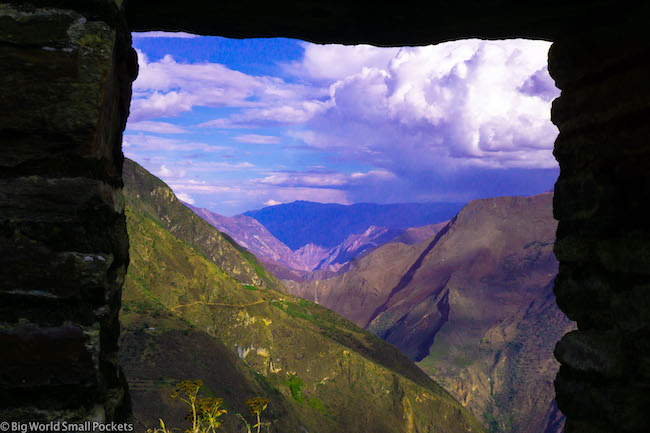
This is a list of the following things I advise you to pack for your Choquequirao trek:
- Sunscreen
- Strong Insect repellent
- Sunglasses
- Sunhat / Cap
- Hiking Poles
- Leggings / Long Pants for Hiking
- Waterproof Jacket for Day Hiking
- Hiking Socks (multiple pairs)
- Changes of T-Shirts & Underwear!
- Hiking Boots
- Warm Hat, Gloves & Puffer Jacket for Evenings
- Sandals for Evening (so you can give your feet a rest from the boots)
- Thermals / Warm Clothes for the Evening / Sleeping
- Sleeping Bag
- Head Lamp
- Toilet Paper & Wet Wipes (multiple packs)
- Water (enough for the 1st day)
- Water Purification Tablets
- Snacks
- Charged Power Bank
- Active Camera like my GoPro Hero 7
- Basic 1st Aid kit inc. Band Aids & Antiseptic Cream
To learn more about what to pack for a Peru trip in general, check out my ultimate Peru packing list here.
Things to Know Before Your Trek
And then there’s just a few more things I thought it might be useful for you to know about the Choquequirao hike.
Some of them I’ve mentioned briefly already, but they are worth making a special note of!
#1 Water
You can buy water along the way – generally at least twice daily at places you’ll stop for lunch or camp. Don’t however underestimate how much water you’ll need / want to drink. Also be prepared that sometimes these places have run out of water. In this case, a little extra water and / or some water purification tablets will go a long way
#2 Accommodation
Camping is the primary mode of accommodation out here, but some of the small villages along the way do have some basic rooms. If you can’t be bothered to pitch your tent one night, or it’s particularly cold, this might be a good option.
#3 Showers / Toilets
Facilities are basic throughout and you’re unlikely to get anything but a cold shower at best. Toilet facilities leave a lot to be desired. Bring your own toilet paper and baby wipes.
#4 Extend your Choquequirao Hike
If the 4 days aren’t enough for you, you can actually extend the Choquequirao hike to continue past the ruins and onto Machu Picchu.
Done as part of a 8-9 day hike, again there are some tour agencies that can sort this for you.
Personally, I think this would be an amazing option if you have the time.
Just enter your details below and I'll email it you - simple!
Information will be sent to the email provided above
Mini Travel Guide to Peru
Best Time to Visit Peru?
The best time to visit Bolivia, in my opinion, is during the dry season in the Andes aka winter in this country – a season which runs largely from the months of June through to October.
Learn more in this article I wrote all about Peru’s climate, weather and the best time to go.
How to Get to Peru?
You can cross land borders with Bolivia, Ecuador and Brazil to reach Peru.
Otherwise, arrive into the international airport in Lima.
As always, I recommend Skyscanner for finding the best deals.
How Long to Spend There?
I’d allow at least 2 weeks to visit Peru if you want to see the highlights of Lima and Cusco.
If you want to add in the Arequipa, the Colca Canyon, Huaraz and the Sacred Valley allow 3-6 weeks.
Travel Safety in Peru
As a solo female traveller, safety when travelling alone (especially in remote areas) is also big on my radar.
Although I have heard and read reports about female travellers being harassed in Peru, I haven’t experienced any of that myself and can only say that I felt incredibly safe here the whole time.
That said, there’s a lot of common sense involved in safety too.
My advice is to stick with other travellers, don’t wander out alone at night and always be clear about your boundaries in all situations.
You’ll also want to ensure you drink enough water as dehydration can be a problem here.
Travelling with a LifeStraw Go Water Bottle, which you can use to purify water from any fresh water source, is a top option to help you do this.
I bought one for my trip to South America – as it then allowed me to drink the tap water safely – and now wouldn’t be anywhere without it!
Sun protection is another thing to factor in for this country and packing clothes (like a cap or hat) and lotion that will protect you from the strong UV rays at that elevation is definitely recommended.
You’ll also want to make sure you pack plenty of warm clothes for the Andes – it gets freezing here at night – including a good coat, gloves, scarf and a hat is a must, we can’t have you catching a cold now!
And finally, when it comes to travel safety in Peru, it’s important to be aware of altitude sickness.
This can be a real danger, sometimes leading to hospitalisation, for travellers whose bodies aren’t used to the lower amounts of oxygen in the air over 2,500m.
Learn more about the symptoms, as well as how to prevent and treat altitude sickness, here.
Travel Insurance for Peru
World Nomads offers simple and flexible travel insurance. Buy at home or while travelling and claim online from anywhere in the world.
Alternatively, if you’re a long-term traveller, digital nomad or frequent remote worker seeking travel health cover, check out Safetywing’s Nomad Insurance policies.
Recommended Peru Tours
If you’re not totally comfortable with travelling this country independently, then a small group or guided tour is a great option that will have you seeing the best of Peru safely, securely and easily.
Check out these top picks for some super ideas and prices.
Want to Volunteer in Peru?
If you want to combine your time travelling in this South American country with giving something back, then why not consider volunteering in Peru?
It could even help you save money and travel for longer!
You can access loads of great volunteer opportunities in this country when you sign up to Worldpackers. Learn more here.
Travel Money in Peru
The easy way to spend abroad with real exchange rates, no markups and no sneaky transaction fees, you can use your Wise card just like a debit card in this country, and it links easily with Google and Apple pay. Grab yours here.
5 Peru Packing Essentials
#1 Good Camera – I would never even think of travelling to Peru without a camera good enough to capture the amazing landscape and people of this country. Both my Sony A6000 and GoPro Hero have been perfect for the job!
#2 Waterproof / Windproof Jackets – With so much of this country situated high in the Andes, taking a waterproof and windproof jacket is essential if you’re going to be hiking or sightseeing in the mountains. I highly recommend the North Face Venture 2.
#3 Hiking Boots – You can’t come to Peru and not do some trekking, so make sure you come prepared with some good, supportive hiking boots… I’ve never worn mine so much in my life! These Keen Targhee II’s are the ideal solution.
#4 Day Pack – Also for the hiking and sightseeing, a good daypack to carry water, snacks, camera, hat, gloves and other clothing layers is key in Peru! This one from Osprey is my pick.
#5 Travel Scarf – And finally, I’ve just discovered the amazing travel wraps from Sholdit and am so happy I took mine to Peru. Acting both as a scarf to keep you warm and a place to store your valuables while you’re out and about, this great invention is perfect for travel in South America.
To learn more about what to pack for a Peru trip in general, check out my ultimate Peru packing list.
PIN IT TO PINTEREST!
And there you have it, everything you need to know about the Choquequirao trek!
Have I missed anything out?
Have any burning questions or useful updated info for other travellers?
Please put it into the comments below and I’ll get back to you 🙂


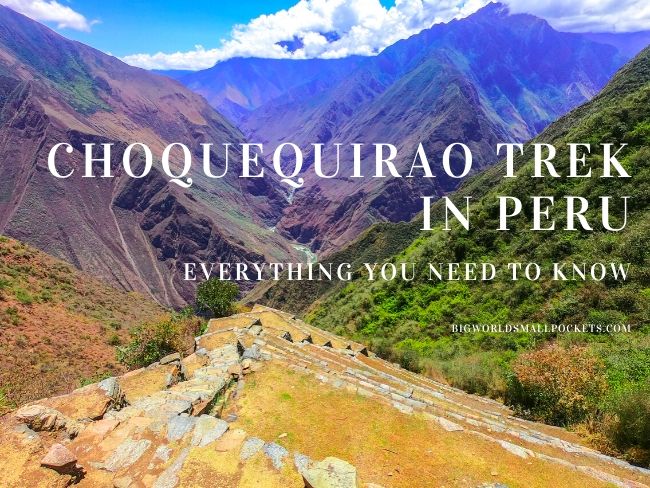
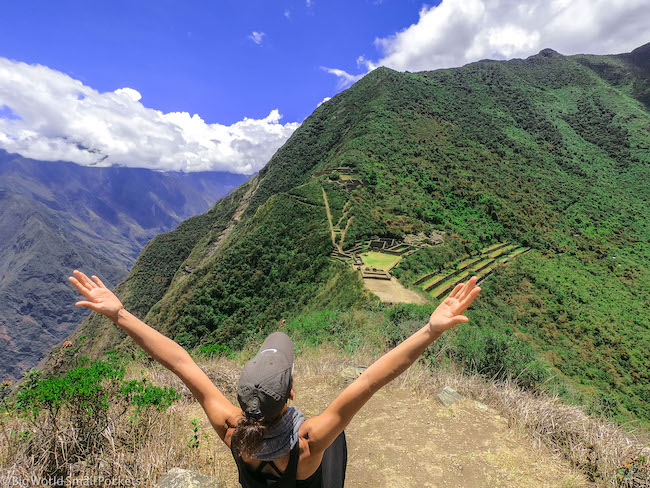
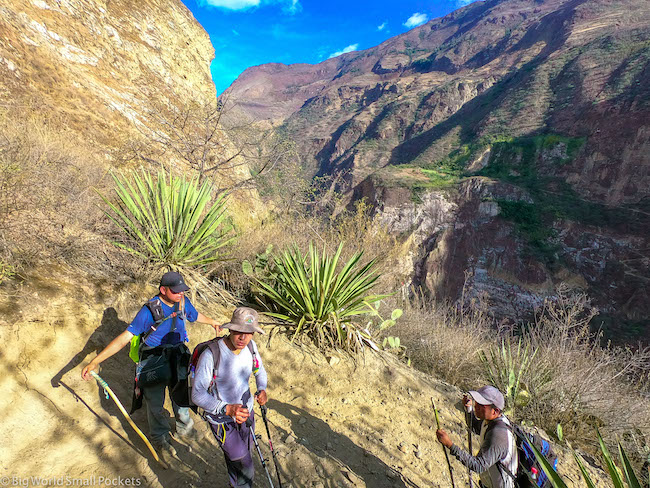
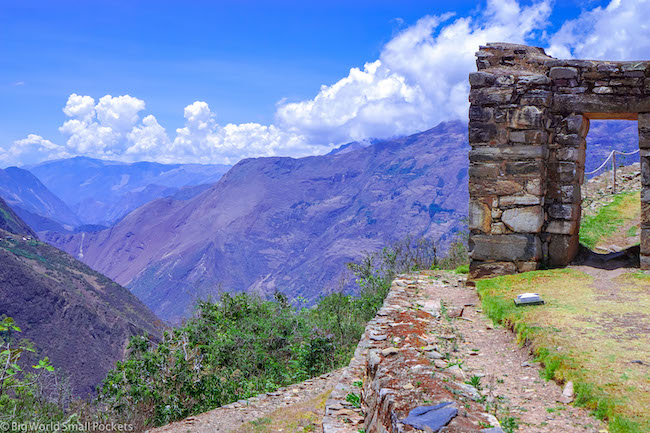

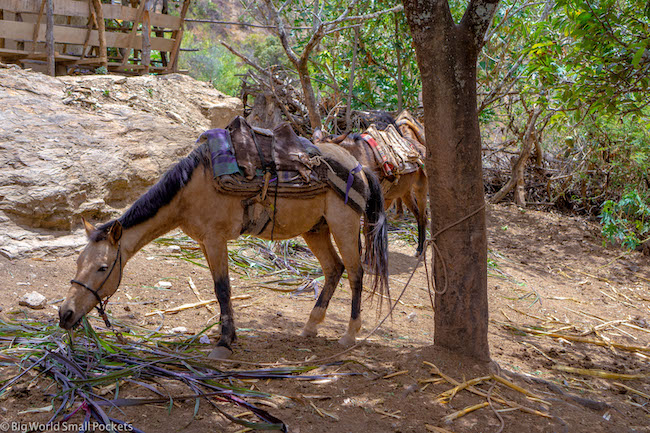
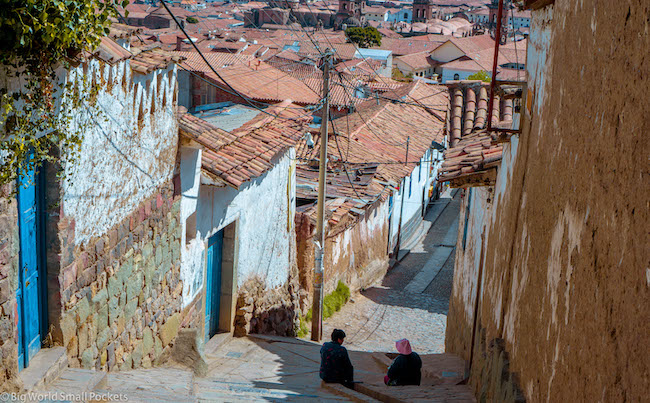
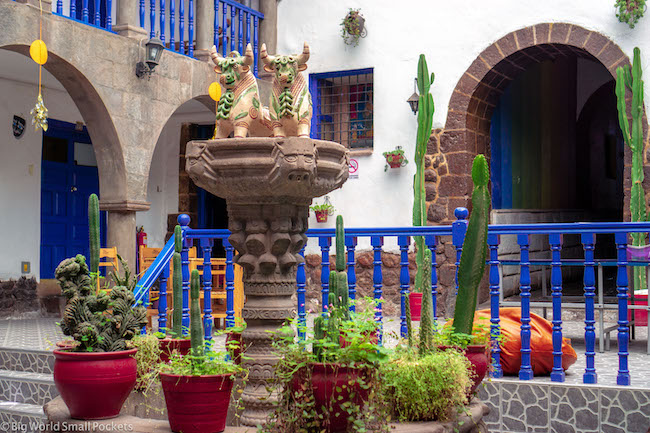
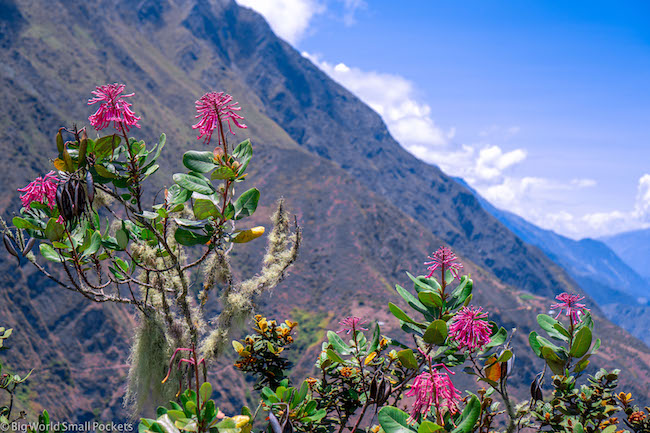
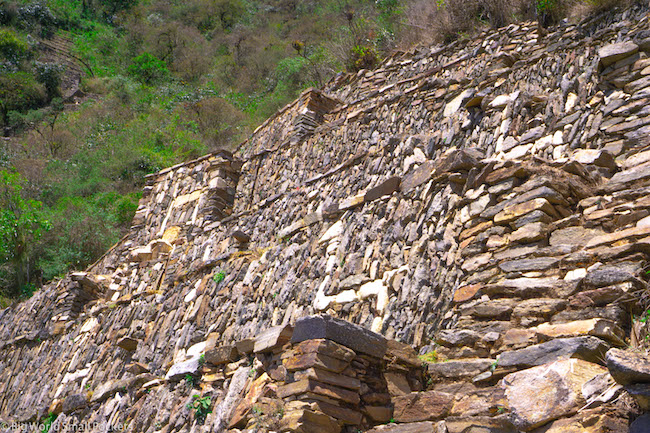
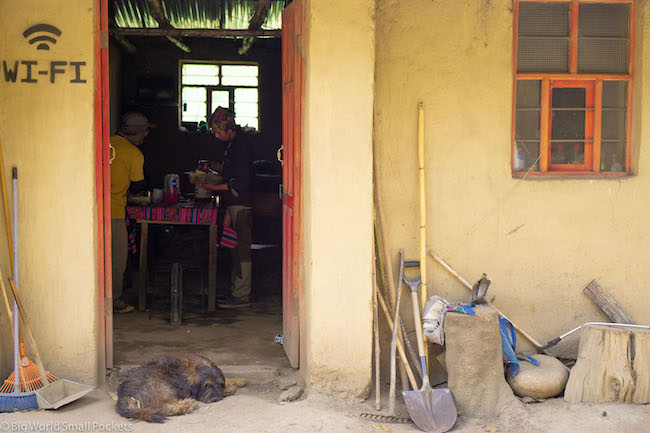
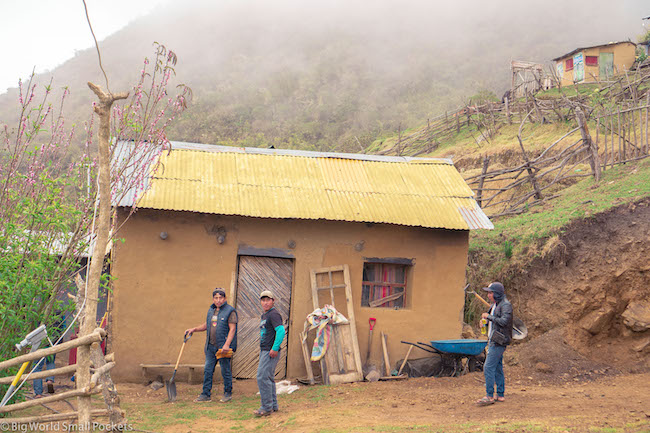
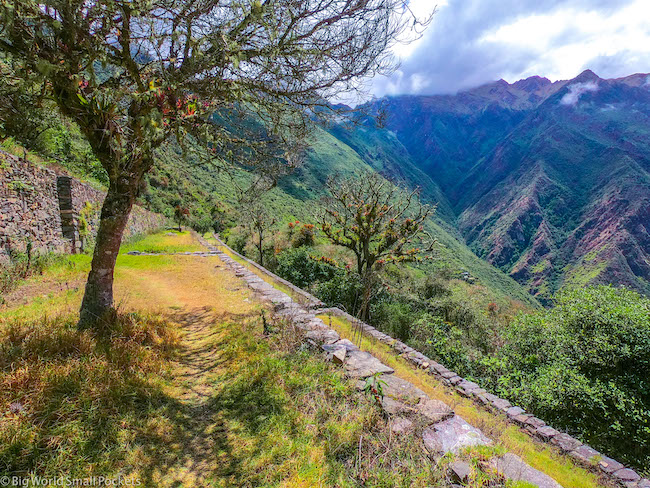
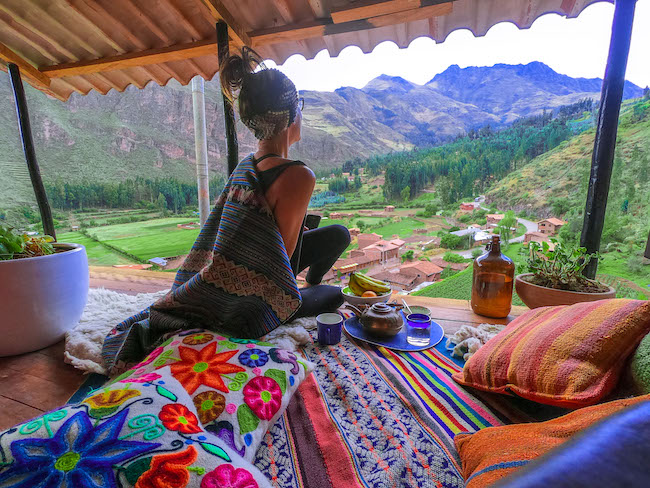
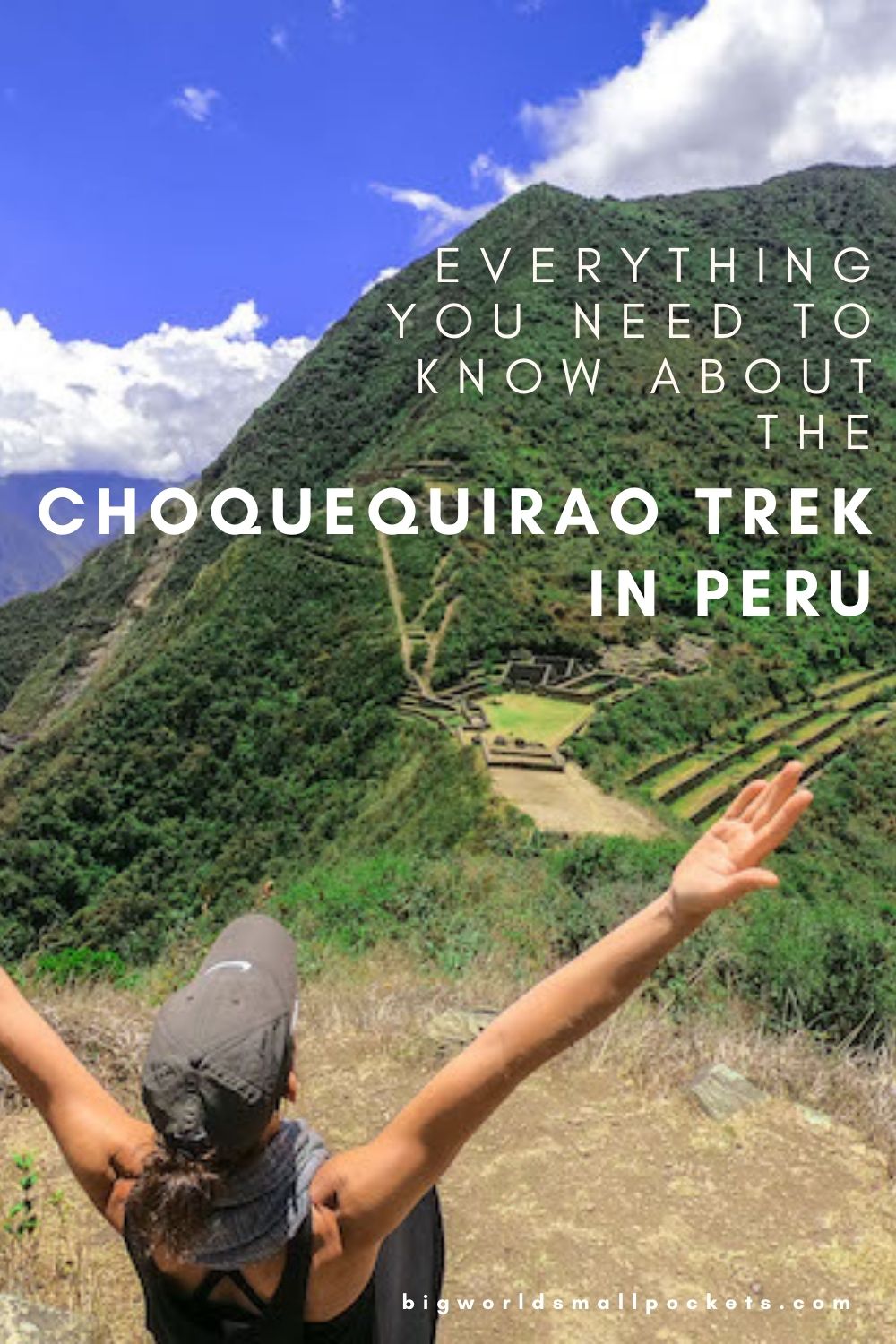
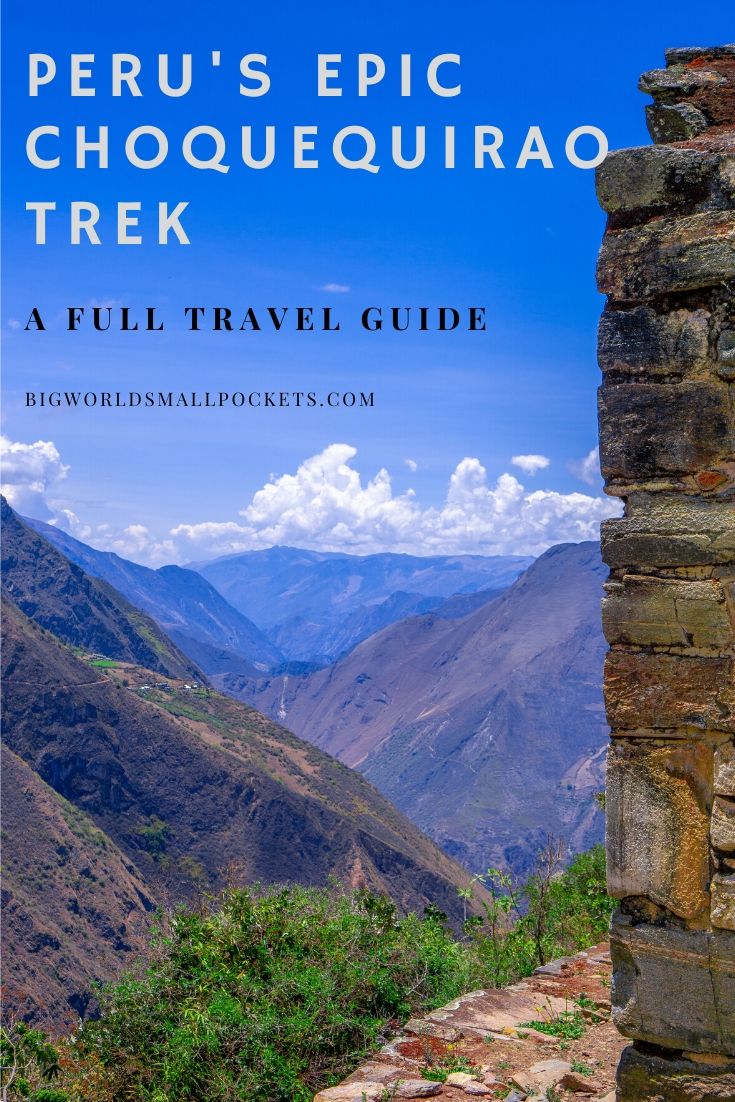
Hi Steph,
Thank you for such a detailed post on hiking to Choquequirao. I have been planning on hiking for quite some time now. I came across many locals in Cusco who advised me on not doing this without a guide. Guess after reading this I am totally up for my solo trek to Choquequirao soon.
Cheers.
Hi Fredy, great to hear you found the post useful. If you are an experienced hiker you can make this alone, but do make sure you download maps.me beforehand and that you are well equipped with water, food, tent etc. You’ll need to take everything with you, including warm layers for the night time. Also check the forecast of course and do ensure you are acclimatised to the altitude. Probably letting someone know in Cusco about your plans and when you’re due back isn’t a bad idea either. Stay safe and enjoy 🙂
HI!! Thank you for sharing your experience and information. I have one question……. I know I won’t do the solo version – at 74 I’ve been there and done that – and will go with a group. My question is 4 days or 5 days for Choque? I am not an archeologist or a very detailed person; I enjoy culture & people more than places. The diff is that with the 5 day you spend more time at Choque – but with the shorter version, can one still appreciate the history/surroundings ? Will I be cheating myself if I go the 4 day route?
THANKS, TAAK, XI XIA, domo, terema kasih, obrigado, selamat, spaciba , etc, etc
Hi Dan, so wonderful to hear you are planning to tackle this hike and very inspiring at your age. I would suggest the 4 day hike is totally fine – you will get enough time at the ruins this way. Although, it is worth bearing in mind this is not really a hike for living culture or people – it’s definitely mostly about the scenery, the experience of camping in the Andes and the ruins, rather than interacting with local people or towns. Hope that info helps. Best wishes, Steph 🙂